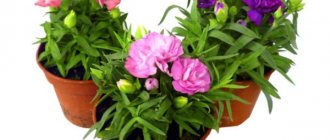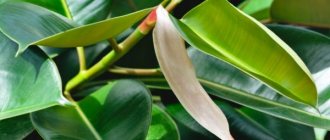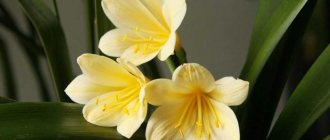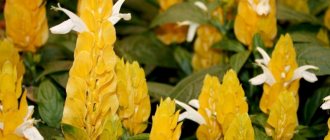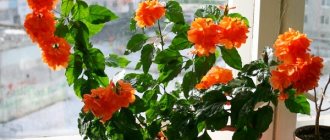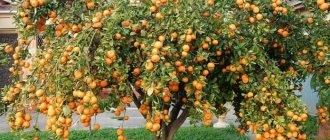Photo gallery
The milky sap secreted by ficus is poisonous, so access to it by children and pets should be limited.
The plant helps purify indoor air from harmful substances, including ammonia, formaldehyde and benzene.
Signs and superstitions
Ficus Daniel is able to benefit all household members. It helps improve a person’s emotional state and mood, relieves fatigue and depression.
The plant has the ability to influence people’s eloquence: those who find it difficult to express thoughts find it easier to conduct a dialogue, and overly talkative people learn to control their speech.
By planting a ficus in a green flowerpot, burying a few coins or bills in the soil and providing proper care, you can attract wealth and prosperity to your home.
A tree growing in a pink pot with hearts on it helps the owner find love or strengthen a marriage.
Married couples, placing a ficus tree at the head of the bed in the bedroom, can count on a quick pregnancy if they provide it with careful care.
How much does it cost and how to choose
The Daniel variety can be bought in many online flower shops, but the pleasure is not cheap.
For a young plant, from 50 cm in height, you will have to pay at least 1000 rubles. A meter will cost even more - 1400-2000 rubles.
It is better to buy a one-year-old specimen so as not to have to guess whether it will take root.
When purchasing, you need to pay special attention to the condition of the crown. The leaves of a healthy plant are smooth and shiny, and the bark is light, without growths or cracks.
Is the plant suitable for bonsai formation?
This variety of ficus has a fairly high growth rate and active branching, which allows you to give the crown the desired appearance and form a miniature bonsai from the tree.
To do this, you need to plant the plant in a small flat pot and trim the roots every six months, shortening them by a third. When the ficus reaches the required height, you need to pinch the top, stimulating the growth of the crown in breadth.
Also, due to the flexibility of the trunks in young specimens, it is possible to form stem systems in the form of braids, spirals or lattices.
Expert opinion
Mokhov Andrey Petrovich
Graduated from KubSAU, specialty: agronomy
Formative pruning can only be done in spring, during the growing season.
Description of Ficus Benjamin
This plant has green, glossy, evergreen leaves with a curved shape. Ficus belongs to the mulberry family (Moraceae), the genus Ficus. This evergreen plant grows wild throughout the tropical zone, mainly in India, China, Malaysia and Australia. The height of growth when grown indoors reaches 200 to 300 cm, rarely higher. The shape of the leaves can be:
- oval;
- ovoid;
- ovate-lanceolate;
- with a smooth or curly edge.
It is also worth remembering that all parts of the plant are toxic and can be dangerous to children and animals. Symptoms of poisoning are nausea, vomiting, and diarrhea. Ficus trees have a tree-like form regardless of size and age, making them ideal for bonsai. In recent years, a trend has emerged for twisting and weaving trunks, so you can make the most intricate and unusual compositions from this plant. You need to start doing this when the trunks and branches are plastic. After lignification, carrying out such procedures with the ficus will be problematic or completely impossible.
When growing ficus indoors, it is important to maintain relatively high humidity for the plant. Regular misting or placing the tree on a pebble tray filled with water is a great way to increase humidity. These plants like high humidity and do not like their roots to be overly wet.
Home care
Lighting and comfortable place
The light should be bright, but diffused. Exposing ficus foliage to direct sunlight causes it to yellow and lose its natural shine.
The most suitable place is the east, west, southeast or southwest side of the room. In the summer, the plant can be taken out into the garden or onto the balcony, shading it during the midday hours.
When choosing a place where ficus Daniel will be located, you need to take into account that it does not tolerate drafts and frequent movements.
Air temperature and humidity
The optimal temperature in spring and summer is +20–25 °C, in winter – not lower than +15 °C.
Humidity should be around 70%. The minimum acceptable rate is 50%; with drier air, the plant withers and dies. Several times a week you need to spray the ficus crown and give it a warm shower every month.
If there is a possibility of a decrease in temperature, it is necessary to insulate the flowerpot and place it on a pallet, and cover the ground with polyethylene.
Disease and pest control
Although the Daniel variety is one of the most resistant, the plant can still get sick. The main symptom is sudden loss of leaves. The reasons for this condition may be:
- Drafts. The tree will hurt if it is placed in a place where there is constant air movement. It will begin to shed its leaves and wither;
- Overfilling or underfilling. These two conditions are equally dangerous for the flower. The moisture level of the earthen clod must be constantly monitored;
- Lack of light. The tree will begin to defoliate every time it lacks sunlight;
- Rearrangement. The plant does not like change. It is better to immediately after purchase determine a permanent place for it in the house and not change it;
- Dry air. For tree health, humidity must be high all year round. Using a regular spray bottle, you can save the plant from drying out foliage.
Fungal diseases rarely affect Danielle. If this happens, the leaves begin to turn yellow and plaque and spots appear on them. It is no longer possible to do without fungicides. You will have to process the entire plant, carefully wiping every leaf and every twig.
Insect pests include: aphids, spider mites, mealybugs and scale insects. Systemic insecticides will help you cope with them: extraflor, biotlin, fitoverm, actara - the most effective. Actellik is also very strong, but it is used only in advanced cases.
The main thing is to notice the “bastard” in time before he causes real damage to the tree.
What kind of soil is needed?
The soil should be loose, nutritious, have good aeration and moisture capacity, and have neutral or weak acidity (pH 5.5–6.5).
You can use soil purchased at a specialized store and intended for growing ficus plants, or prepare a soil mixture yourself by mixing in equal parts:
Did you get a bonsai from Daniel?
Not really
- turf;
- leaf soil;
- coarse sand;
- peat.
To help the ficus take root, bone meal should be added to the substrate at the rate of 1 g per kg. soil.
You can disinfect the soil and get rid of pests and microorganisms in it using heat treatment or a manganese solution.
Transfer
The regularity of replanting depends on the individual characteristics of the ficus - the more intensively it grows, the more often it needs to replace the soil and flowerpot. On average, a young specimen needs to be replanted annually in the spring-summer period, a flower older than 4 years – once every 3-4 years.
The need for the procedure is indicated by:
- overgrown root system;
- presence of pests or diseases;
- unsuitable soil.
Also, a transplant is required at the end of the adaptation period after purchase.
For ficus Daniel, a pot made of porous material with drainage holes is suitable, the height of which should be about a third of the total size of the tree.
Expert opinion
Mokhov Andrey Petrovich
Graduated from KubSAU, specialty: agronomy
If the container is too large, the plant will direct all its energy to growing roots.
The most suitable method of transplantation is transshipment:
- At the bottom of the new pot, pour a layer of drainage consisting of pebbles, expanded clay or ceramic shards and sprinkle the prepared soil on top;
- water the plant generously and carefully remove it from the old flowerpot;
- place the ficus together with the earthen lump in the center of the new container;
- add soil, filling the voids, so that the root collar is flush with the ground;
- water the plant and place it in a warm, well-lit place.
Proper care of Ficus Benjamin
Ficus can be safely described as a fastidious specimen that loves proper care, care and love. If all rules are followed in creating a favorable microclimate, it will thank the owners with its beauty and protect the house from the negative influences of the external environment.
Choosing a pot
Young ficus is characterized by intensive growth. That is why it requires an annual transplant and replacement of the pot. In this case, the diameter of the old pot should be 20–30 mm smaller than the new one. After the bush is four years old, there is no need to regularly replace pots.
To avoid stagnation of liquid in the soil mixture, when planting ficus, select a container with holes at the bottom for drainage. The pot can be made of any material, for example: plastic or ceramic.
Lighting
Ficus benjamina belongs to the category of light-loving plants, especially for variegated varieties. Green species can take root in the shade, but bright lighting remains more favorable for them. A young bush can be gradually accustomed to being in direct sunlight. Rearranging it with a change in location relative to the light source can harm the plant. In some cases, this leads to the shedding of leaves.
Temperature
Since ficus benjamina comes from the tropics, it is quite thermophilic. It feels comfortable in temperatures from +25C to +35C. The plant can tolerate higher degrees, but with regular spraying. Special care is needed in winter. It is advisable to move flowerpots located on the floor or windowsill to places where cold drafts are excluded. The optimal winter temperature is +15C...+18C.
Humidity
Creating conditions of high humidity is vital for home ficus. In the warm season it is sprayed daily, in winter - less often. Also, the plant is periodically given a refreshing shower, which promotes healthy development and rids the crop of the possible appearance of spider mites, scale insects and other pests.
Suitable soil mixture
In order for Ficus Benjamin to grow and develop normally, it is necessary to use a substrate of a certain composition for planting it, for example:
- sand, leaf and turf soil, charcoal;
- turf and leaf soil, sand and peat.
When planting or replanting, do not forget to make a good layer of expanded clay drainage at the bottom of the pot.
Spraying
For normal growth and development, the shrub requires high air humidity, so it should be systematically moistened with a spray bottle. Particular attention should be paid to moistening the foliage during the heating season in winter and on hot summer days.
You can also increase the level of air humidity in another way. To do this, pour expanded clay into the pan and pour in a little water. Place a pot with a plant on top.
Watering
Ficus benjamina loves water and does not tolerate dry soil. This should be monitored especially closely during hot periods, providing plenty of fluids. In winter, weekly one-time watering is sufficient. When the soil dries out, the bushes shed their leaves.
Fertilizers and fertilizing
To maintain the succulence of the leaves and the successful growth of the crown of Ficus Benjamin, useful fertilizing is necessary. Starting from May, fertilizing components are applied once every 20 days, in the summer - once every two weeks. With the onset of autumn, by mid-September, feeding stops, as the plant must enter a dormant state. Renewal of fertilization should begin in March, applying once a month.
Organic and mineral compounds and plant compost mixtures act as fertilizers. Nitrogen-containing fertilizers have a particularly good effect on the growth of green mass. You can also use proven folk recipes, for example, sugar syrup, diluting sugar with water in a ratio of 1 tbsp. spoon per 1 liter of water (this is enough for two or three pots). Glucose is an excellent source of energy for the life processes of a flower, if you do not overdo it with doses.
Trimming
Most varieties of Ficus Benjamin require periodic pruning to rejuvenate and take on beautiful shapes, for example, spherical, in the form of original sculptures or in the form of a bonsai. Pruning is carried out in the spring, when the crop grows especially quickly. It is important to use only a sterile instrument and not damage the bark. The cut is made at an angle towards the top edge.
Read on topic: How to sew Roman blinds: a detailed guide
Transfer
The process is carried out in spring or summer, when roots begin to protrude from below. This usually happens once every 3 years. To make the plant comfortable and prevent the formation of a salt crust, it is enough to change the top layer annually.
Transplant technology:
- The soil is moistened and the top layer is removed.
- The plant is removed and the roots are shaken off.
- The lump is transferred into a new pot with a layer of expanded clay.
- The free space is filled with a prepared soil mixture of river sand and compost mixed with 2 parts of leaf soil. The addition of horn shavings enriches the soil with useful substances.
Preparing for winter
Ficus is an evergreen plant, so if it begins to shed its leaves in winter, it may be due to lack of lighting. In this case, the tree is provided with artificial lighting. The total daylight hours in winter should be about 12-14 hours.
In winter, air humidity should be 60-70%, so the plant is additionally sprayed with a spray bottle. When there is a lack of moisture, the tree sheds its leaves.
If the flower pot is located on the windowsill, then you need to protect the plant from touching cold glass.
Attention! Avoid watering the flower with cold water.
If the pot is on the floor, it is advisable to raise it. You can install it on an insulating pad made of fabric or wood.
Bloom
Most gardeners are not aware that Ficus Benjamina is actually a flowering plant. The fact is that when grown at home it does not bloom. But even in nature and in greenhouse conditions, during flowering, not flowers are formed on it, but syconia, which are modified inflorescences that look like round peas.
If, when growing in a greenhouse, similar flowers appear on a weakened bush, then experts recommend that they be removed. The fact is that ficus spends a lot of energy on flowering.
Ficus care video
Preparing tomato seeds for sowing for seedlings: methods for disinfection and accelerated germination of seeds Globular chrysanthemum multiflora: planting and care, wintering
Reproduction
Ficus Daniel is propagated by cuttings, air layering and seeds.
By cuttings
The most common method at home, for which you need:
- prepare apical cuttings with growth buds and leaves;
- wash off the milky juice that appears, dry the sections and treat them with a growth stimulator - “Kornevin”, “Heteroauxin”;
- place the seedlings in a container with water, which subsequently needs to be changed every 2-3 days, or in a substrate consisting of equal parts of perlite or coarse sand and peat;
- cover the container with polyethylene and keep at a temperature of +22–25 °C, ventilating regularly.
The roots should appear after 2-3 weeks, after which the cuttings must be planted in separate flowerpots with soil suitable for adult ficuses.
Air layering
This method requires a woody shoot, at the edge of which you need to make an incision and remove part of the bark. Wash off the juice from this area, treat it with Kornevin, wrap it in damp sphagnum moss and cover it with polyethylene.
After 3-4 weeks, roots will begin to grow through the moss. After they appear, the resulting shoot should be cut off and planted in a separate container with a suitable soil mixture. This method can be used before the start of the growing season.
Seeds
First of all, planting material should be treated with a growth stimulator and fungicides (Fundazol). After this, sow the seeds on the surface of loose soil, cover the container with polyethylene or glass to create a greenhouse effect and place it in a well-lit place at a temperature of +22–25 °C, constantly ventilating and watering.
After 10–15 days, seedlings appear that need to be picked and later planted in individual flowerpots.
What ficus Daniel looks like
Ficus Benjamin Daniel is difficult to classify as a flowering family, since in the classical sense it is a tree that feels great in a pot. In good conditions it can grow up to 2 m.
Common varieties
In nature, there are up to 1000 species of different ficuses. Almost all of them are attractive with their foliage and spreading crown. Leaf plates are:
- plain;
- with spots;
- small;
- big.
Ficus Daniel greenery that fits into any design
In addition to Daniel, the following domesticated varieties are known:
- Starlight;
- Natasha;
- Kinky;
- Golden King;
- Viandi;
- Exotic;
- Carly;
- Fantasy;
- Monique.
Medicinal properties
Plant growers really appreciate the beneficial qualities of the ficus Daniel; caring for it at home is not difficult. In response to care, he is able to purify the air. Daniel absorbs dust and harmful impurities like a sponge. This is a real green orderly that absorbs benzenes, formaldehydes and ammonia.
It is also believed that ficus can improve the psychological atmosphere in the apartment. The plant improves energy, neutralizes anxiety and anger.
Note! In China, even a photo of a ficus is considered favorable for the home environment.
The greenery of the flower is favorable for the home
Daniel's story begins in ancient times. The tombs in Egypt are made from the wood of this plant. Some ficus trees are considered sacred.
Watering
The frequency of watering depends on the rate of drying of the top layer of soil - drying out the roots is detrimental to the plant, as well as waterlogging them.
As a rule, it is necessary to moisten the soil twice a week in summer and 2-3 times a month in winter.
The liquid flowing into the pan must be drained, otherwise there is a risk of developing root rot.
The water should be at room temperature, soft, and left for 24 hours.
If you are going on vacation
You can preserve moisture in the flowerpot for a while by laying hydrogel or damp sphagnum moss on the top layer of soil and covering the plant with polyethylene.
What to do if ficus benjamina drops leaves
If you are faced with the problem of dropping leaves, then pay attention to the soil: a lack of moisture affects it just as bad as waterlogging. Foliage may also fall if there is a high level of air dryness, temperature changes, or the tree is standing in a too cold room. Do not forget that this royal flower is not watered with cold water!
If you do everything right, your trees will look divine!
We have discussed the basic steps for caring for this plant. We hope that our recommendations will help you eliminate mistakes when raising your pet.
How to resuscitate if the leaves have completely fallen
If the plant is not properly cared for or damaged, the leaf fall can shed its leaves in a few days. A number of reasons can lead to this. The resuscitation process consists of the following stages:
- Finding out the cause of leaf fall. It may be caused by poor (insufficient or excessive) watering. Check whether watering was organized correctly. To do this, pierce the ground at the root with a wooden stick and pull it out. If it is dry, then the plant needs to be watered.
- If the leaf fall is due to the fault of parasites, then first get rid of them. Then the plant is periodically sprayed with Zircon, Epin or similar preparations that will help fight stress.
- Adjust the conditions of detention.
- If there are no positive results, then the plant needs to be removed from the pot and the root system inspected, the rotten roots removed and replanted in a new pot.
- The bare tree can be placed in a plastic bag and a mini-greenhouse can be created until it is completely restored.
Ficus is a very beautiful and not very demanding plant that will fit perfectly into the interior of any home.
Diseases. Table
| Disease | Signs | Cause | Treatment |
| Powdery mildew | The appearance of white pellets on the leaf plates | Keeping at high temperature and humidity | Cut off the affected parts of the plant, treat with fungicides (Bona Forte, Storby) |
| Root rot | Withering and falling leaves, rotting roots | Excessive watering in combination with low air temperatures | Carry out a transplant, completely replacing the soil and flowerpot, remove all diseased areas of the root system, treat the ficus with the preparation “Maxim”, “Glyokladin” or “Discor” |
Description and characteristics
The flower culture is distinguished by the small size of the leaf blades (5 cm) and dark green color, as well as a shiny glossy surface. The leaves have smooth edges, an elongated shape and pointed ends. Ficus is a pliable plant, the flexible shoots and young branches of which can not only be woven together, but also form various original shapes. In its usual form, it is a shrub with a main trunk and side branches growing vertically. Young foliage is light green in color.
In its natural environment - the tropical zone of Asia, West Africa and Australia, the evergreen tree reaches a height of 30 m. In order for an exotic guest to actively grow and develop, he needs to create comfortable living conditions, paying special attention to air temperature and humidity levels.
Problems with leaves. Table
| Problem | Cause | Solution |
| Premature yellowing and crown drop | Overwatering | Establish soil moisture regime |
| Intensive leaf fall | Lack of lighting, drafts, frequent changes of location | When daylight is short, use phytolamps, eliminate the possibility of drafts, do not move the flowerpot |
| The tips of the leaves have become dry and have acquired a brown tint. | Low air humidity | Spray the plant regularly |
Pests. Table
| Pest | Signs | Ways to fight |
| Mealybug | Yellowing of the crown, formation of white pellets on the leaves | Spray the plant with Fitoverm or Confidor |
| Spider mite | The appearance of white dots on the back of leaf blades and thin cobwebs on branches and leaves | Treat the tree with insecticides “Akarin”, “Omite”, “Apollo” |
| Shchitovka | The appearance of a sticky coating on the trunk and leaves | Moisten a piece of cloth or a cotton pad in a soap solution and remove insects mechanically, treat the ficus with “Aktara”, and a week later with “Confidor” or “Commander” |
| Aphid | The foliage becomes pale, a white coating appears on it, and begins to fall off over time. | Treatment with soap-alcohol solution and insecticides (“Akarin”, “Fufanon”) |
Ficus benjamina - photo
Ficus Benjamin, which has a rich variety of varietal species with expressive foliage and original trunk skeletons, is an excellent material for phyto-design. The plant can become not only a worthy interior decoration, but also attract the eyes of passers-by, spread out in the local area. A selection of high-quality photos presented in the gallery will tell you much more about ficus. Enjoy watching!
Sources
- https://sadalisa.ru/komnatnye-rasteniya/kak-uhazhivat-za-fikusom-bendzhamina-v-domashnih-usloviyah
- https://rastenievod.com/fikus-bendzhamina.html
- https://kitchendecorium.ru/accessories-decor/garden/fikus-bendzhamina.html
- https://trudogolikam.ru/flora-i-fauna/fikus-bendzhamina-samye-krasivye-sorta.html
- https://Trizio.ru/fikus-bendzhamina-90-foto-866
- https://cemicvet.mediasole.ru/fikus_bendzhamina_uhod_v_domashnih_usloviyah_foto
- https://pocvetam.ru/komnatnye-rasteniya/fikus-bendzhamina-uxod-v-domashnix-usloviyax.html
- https://cvetok-v-dome.ru/dekorativno-listvennye/fikus-bendzhamina-pravila-uxoda-v-domashnix-usloviyax/
- https://krrot.net/fikus-v-domashnix-ysloviya/
- https://agronom.guru/fikus-bendzhamina-uhod-v-domashnih-usloviyah-foto
